Why you can trust TechRadar
Always-on display
One of the best features of the Samsung Galaxy S7 Edge is that it'll never be turned off (as long as there's still battery life left inside the thing).
Where before you'd have to wake the phone to see the time or check your notifications, now the screen permanently displays a clock, calendar or pattern.
It's something that impressed us much more than we were expecting. The number of times we'd approach the phone on a desk and wonder why the display was on were too many to shamelessly admit, but each time we found ourselves admiring the feature.

We're still torn over whether this is a battery-saving feature or not. It takes about 0.8% per hour of your phone's juice by our reckoning, and over 24 hours, that's around a fifth of the battery power gone just so you can avoid buying a watch.
But Samsung believes we unlock our phones over 150 times a day, and by stopping us doing that the device is no longer waking up, starting the CPU and connecting to reams of data services, which in turn saves battery.
In practice, that claim seemed to bear out, although turning the display off at night is a must, as we couldn't handle it lighting up the room, despite only a very small area of pixels being left on to show the time.
It's irritating that you can't have it turn off at a certain time of the night; instead, you can only switch to the Night Display, which is a similar thing but with less information down the side of the phone. We know you can just turn the phone over, but it seems like a missed opportunity.
However, there was one big flaw with the always-on display – it didn't show all your notifications.

The good news is that with a software update (ported from the Note 7) Samsung has allowed more patterns and options for the Always-on Display, as well as giving you more notifications to let you know if there's a WhatsApp message waiting.
This makes the Always-on Display far more useful, and brings it inline with the offering on the Samsung Galaxy S8 and S8 Plus.
Super-fast charging
There's nothing quite so frustrating as running out of smartphone juice when you need it the most, and Samsung's trying to solve that issue in a couple of ways.
The main thing at work here is Adaptive Fast Charging, where the phone can work out precisely the best way to get juice into your phone.
You'll need to use the charger that comes in the box, as alternatives that promise to do a similar thing won't work as well, if at all.
In theory, Samsung believes you can get 50% battery life out of this charger in just 30 minutes – but in testing that's not quite the case, with about 35-40% juice incoming during that half hour – and the phone gets pretty hot in the process.

You'll need to turn the phone off to make sure you're getting the maximum charging speed though, so don't expect such fast refuelling if you're not going to be able to live without your handset for that amount of time.
Samsung has also improved the charging speed through the wireless charging on the back of the handset.
The 'trigger point' is pretty small though, so you'll need to wiggle it around on a pad to make sure it's got the correct contact – not really the point of wireless charging, but it's good to be able to just lay the phone down on your known portion of the desk and have it work.
The speed here again depends on which charger you use – the Samsung charger is apparently pretty rapid, but as we didn't have this in the box to test we're not able to confirm whether it's easier and quicker to use than others.
Current page: Always-on display and super-fast charging
Prev Page Introduction, design and screen Next Page Game Launcher and microSD slot
Gareth has been part of the consumer technology world in a career spanning three decades. He started life as a staff writer on the fledgling TechRadar, and has grew with the site (primarily as phones, tablets and wearables editor) until becoming Global Editor in Chief in 2018. Gareth has written over 4,000 articles for TechRadar, has contributed expert insight to a number of other publications, chaired panels on zeitgeist technologies, presented at the Gadget Show Live as well as representing the brand on TV and radio for multiple channels including Sky, BBC, ITV and Al-Jazeera. Passionate about fitness, he can bore anyone rigid about stress management, sleep tracking, heart rate variance as well as bemoaning something about the latest iPhone, Galaxy or OLED TV.
